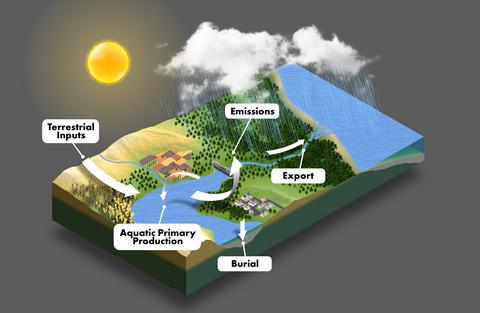当前位置:
X-MOL 学术
›
Glob. Change Biol.
›
论文详情
Our official English website, www.x-mol.net, welcomes your
feedback! (Note: you will need to create a separate account there.)
Anthropogenically driven climate and landscape change effects on inland water carbon dynamics: What have we learned and where are we going?
Global Change Biology ( IF 10.8 ) Pub Date : 2022-07-20 , DOI: 10.1111/gcb.16324 Rachel M Pilla 1 , Natalie A Griffiths 1 , Lianhong Gu 1 , Shih-Chieh Kao 1 , Ryan McManamay 1, 2 , Daniel M Ricciuto 1 , Xiaoying Shi 1
Global Change Biology ( IF 10.8 ) Pub Date : 2022-07-20 , DOI: 10.1111/gcb.16324 Rachel M Pilla 1 , Natalie A Griffiths 1 , Lianhong Gu 1 , Shih-Chieh Kao 1 , Ryan McManamay 1, 2 , Daniel M Ricciuto 1 , Xiaoying Shi 1
Affiliation

|
Inland waters serve as important hydrological connections between the terrestrial landscape and oceans but are often overlooked in global carbon (C) budgets and Earth System Models. Terrestrially derived C entering inland waters from the watershed can be transported to oceans but over 83% is either buried in sediments or emitted to the atmosphere before reaching oceans. Anthropogenic pressures such as climate and landscape changes are altering the magnitude of these C fluxes in inland waters. Here, we synthesize the most recent estimates of C fluxes and the differential contributions across inland waterbody types (rivers, streams, lakes, reservoirs, and ponds), including recent measurements that incorporate improved sampling methods, small waterbodies, and dried areas. Across all inland waters, we report a global C emission estimate of 4.40 Pg C/year (95% confidence interval: 3.95–4.85 Pg C/year), representing a 13% increase from the most recent estimate. We also review the mechanisms by which the most globally widespread anthropogenically driven climate and landscape changes influence inland water C fluxes. The majority of these drivers are expected to influence terrestrial C inputs to inland waters due to alterations in terrestrial C quality and quantity, hydrological pathways, and biogeochemical processing. We recommend four research priorities for the future study of anthropogenic alterations to inland water C fluxes: (1) before-and-after measurements of C fluxes associated with climate change events and landscape changes, (2) better quantification of C input from land, (3) improved assessment of spatial coverage and contributions of small inland waterbodies to C fluxes, and (4) integration of dried and drawdown areas to global C flux estimates. Improved measurements of inland water C fluxes and quantification of uncertainty in these estimates will be vital to understanding both terrestrial C losses and the “moving target” of inland water C emissions in response to rapid and complex anthropogenic pressures.
中文翻译:

人为驱动的气候和景观变化对内陆水域碳动态的影响:我们学到了什么,我们要去哪里?
内陆水域是陆地景观和海洋之间的重要水文联系,但在全球碳 (C) 预算和地球系统模型中经常被忽视。从分水岭进入内陆水域的陆地衍生 C 可以运输到海洋,但超过 83% 被埋在沉积物中或在到达海洋之前排放到大气中。气候和景观变化等人为压力正在改变内陆水域这些 C 通量的大小。在这里,我们综合了 C 通量的最新估计以及内陆水体类型(河流、溪流、湖泊、水库和池塘)的不同贡献,包括最近的测量,包括改进的采样方法、小型水体和干燥区域。在所有内陆水域,我们报告的全球 C 排放估计值为 4。40 Pg C/年(95% 置信区间:3.95–4.85 Pg C/年),比最近的估计增加 13%。我们还回顾了全球最广泛的人为驱动的气候和景观变化影响内陆水 C 通量的机制。由于陆地碳质量和数量、水文路径和生物地球化学过程的变化,这些驱动因素中的大多数预计会影响到内陆水域的陆地碳输入。我们建议未来研究内陆水域 C 通量的人为改变的四个研究重点:(1)与气候变化事件和景观变化相关的 C 通量的前后测量,(2)更好地量化来自陆地的 C 输入, (3) 改进了对小型内陆水体对 C 通量的空间覆盖和贡献的评估,(4) 将干燥和下降区域整合到全球 C 通量估计中。改进内陆水域 C 通量的测量和这些估计中不确定性的量化对于了解陆地 C 损失和内陆水域 C 排放的“移动目标”以响应快速和复杂的人为压力至关重要。
更新日期:2022-07-20
中文翻译:

人为驱动的气候和景观变化对内陆水域碳动态的影响:我们学到了什么,我们要去哪里?
内陆水域是陆地景观和海洋之间的重要水文联系,但在全球碳 (C) 预算和地球系统模型中经常被忽视。从分水岭进入内陆水域的陆地衍生 C 可以运输到海洋,但超过 83% 被埋在沉积物中或在到达海洋之前排放到大气中。气候和景观变化等人为压力正在改变内陆水域这些 C 通量的大小。在这里,我们综合了 C 通量的最新估计以及内陆水体类型(河流、溪流、湖泊、水库和池塘)的不同贡献,包括最近的测量,包括改进的采样方法、小型水体和干燥区域。在所有内陆水域,我们报告的全球 C 排放估计值为 4。40 Pg C/年(95% 置信区间:3.95–4.85 Pg C/年),比最近的估计增加 13%。我们还回顾了全球最广泛的人为驱动的气候和景观变化影响内陆水 C 通量的机制。由于陆地碳质量和数量、水文路径和生物地球化学过程的变化,这些驱动因素中的大多数预计会影响到内陆水域的陆地碳输入。我们建议未来研究内陆水域 C 通量的人为改变的四个研究重点:(1)与气候变化事件和景观变化相关的 C 通量的前后测量,(2)更好地量化来自陆地的 C 输入, (3) 改进了对小型内陆水体对 C 通量的空间覆盖和贡献的评估,(4) 将干燥和下降区域整合到全球 C 通量估计中。改进内陆水域 C 通量的测量和这些估计中不确定性的量化对于了解陆地 C 损失和内陆水域 C 排放的“移动目标”以响应快速和复杂的人为压力至关重要。











































 京公网安备 11010802027423号
京公网安备 11010802027423号